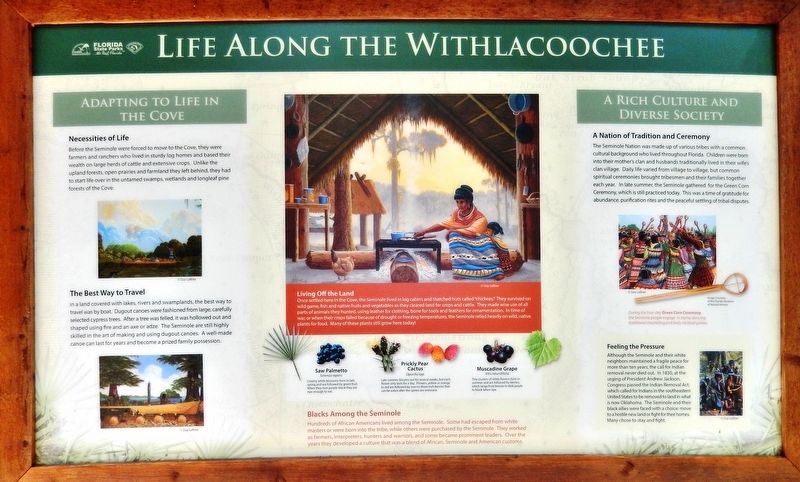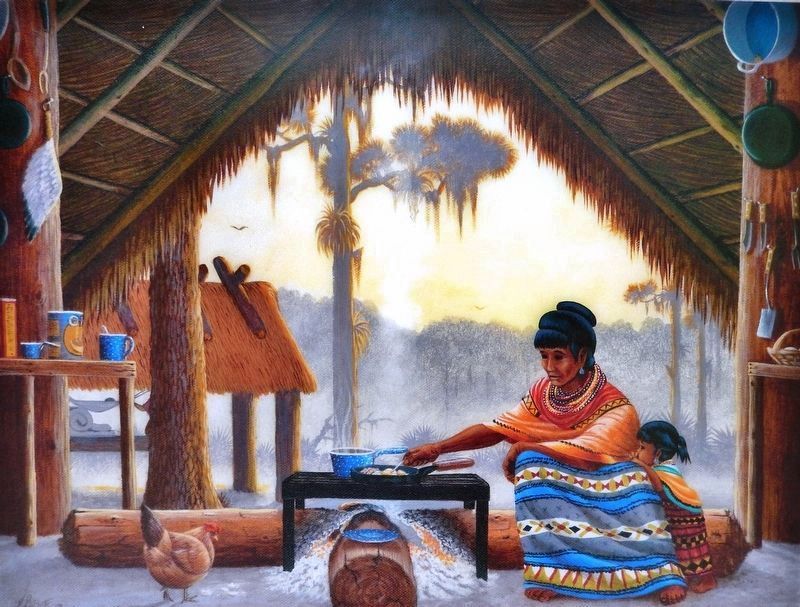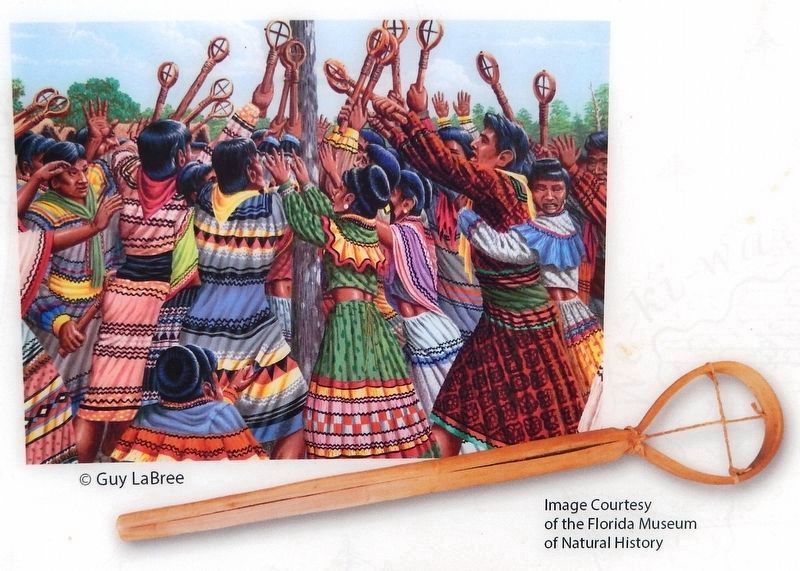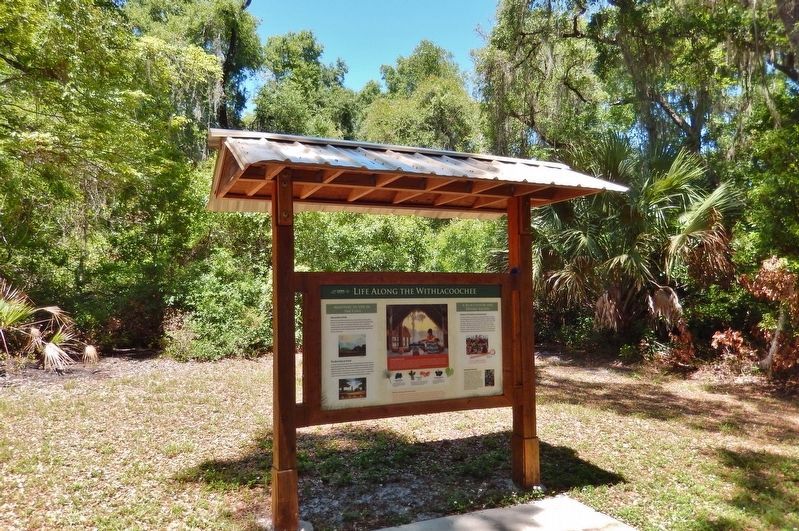Near Inverness in Citrus County, Florida — The American South (South Atlantic)
Life Along the Withlacoochee
Seminole Heritage Trail
Adapting to Life in the Cove
Necessities of Life
Before the Seminole were forced to move to the Cove, they were farmers and ranchers who lived in sturdy log homes and based their wealth on large herds of cattle and extensive crops. Unlike the upland forests, open prairies and farmland they left behind, they had to start life over in the untamed swamps, wetlands and longleaf pine forests of the Cove.
The Best Way to Travel
In a land covered with lakes, rivers and swamplands, the best way to travel was by boat. Dugout canoes were fashioned from large, carefully selected cypress trees. After a tree was felled, it was hollowed out and shaped using fire and an axe or adze. The Seminole are still highly skilled in the art of making and using dugout canoes. A well-made canoe can last for years and become a prized family possession.
Living Off the Land
Once settled here in the Cove, the Seminole lived in log cabins and thatched huts called "chickees." They survived on wild game, fish and native fruits and vegetables as they cleared land for crops and cattle. They made wise use of all parts of animals they hunted, using leather for clothing, bone for tools and feathers for ornamentation. In time of war, or when their crops failed because of drought or freezing temperatures, the Seminole relied heavily on wild, native plants for food. Many of these plants still grow here today!
Saw Palmetto Serenoa repens
Creamy white blossoms form in late spring and are followed by green fruit. When they turn purple-black they are ripe enough to eat.
Prickly Pear Cactus Opuntia spp.
Late summer blooms last for several weeks, but each flower only lasts for a day. Flowers, yellow or orange to red are followed by one-to-three inch berries that can be eaten after the spines are removed.
Muscadine Grape Vitis rotundifolia
Tiny clusters of white flowers form in summer and are followed by berries, which range from bronze to dark purple to black when ripe.
Blacks Among the Seminole
Hundreds of African Americans lived among the Seminole. Some had escaped from white masters or were born into the tribe, while others were purchased by the Seminole. They worked as farmers, interpreters, hunters and warriors, and some became prominent leaders. Over the years they developed a culture that was a blend of African, Seminole and American customs.
A Rich Culture and Diverse Society
A Nation of Tradition and Ceremony
The Seminole Nation was made up of various tribes with a common cultural background who lived throughout Florida. Children were born into their mother's clan and husbands traditionally lived in their wife's clan village. Daily life varied from village to village, but common spiritual ceremonies brought tribesmen and their families together each year. In late summer, the Seminole gathered for the Green Corn Ceremony, which is still practiced today. This was a time of gratitude for abundance, purification rites and the peaceful settling of tribal disputes.
Feeling the Pressure
Although the Seminole and their white neighbors maintained a fragile peace for more than ten years, the call for Indian removal never died out. In 1830, at the urging of President Andrew Jackson, Congress passed the Indian Removal Act, which called for Indians in the southeastern United States to be removed to land in what is now Oklahoma. The Seminole and their black allies were faced with a choice: move to a hostile new land or fight for their homes. Many chose to stay and fight.
Topics. This historical marker is listed in these topic lists: African Americans • Native Americans • Settlements & Settlers • Wars, US Indian.
Location. 28° 48.437′ N, 82° 18.383′ W. Marker is near Inverness, Florida, in Citrus County. Marker can be reached from Old Floral City Road, 0.2 miles south of Carnegie Drive, on the right when traveling south. Marker is located within
Fort Cooper State Park, along the Seminole Heritage Trail, about 8/10 mile inside the park and a short walk from the parking lot. Touch for map. Marker is at or near this postal address: 3100 South Old Floral City Road, Inverness FL 34450, United States of America. Touch for directions.
Other nearby markers. At least 8 other markers are within walking distance of this marker. Fort Cooper (about 600 feet away, measured in a direct line); Florida's First People (approx. 0.2 miles away); The Seminole in the Cove of the Withlacoochee (approx. 0.2 miles away); Old Military Road (approx. 0.2 miles away); War Comes to the Cove (approx. 0.2 miles away); Lonely Outpost in a Hostile Land (approx. ¼ mile away); A Costly Florida War (approx. 0.3 miles away); a different marker also named Fort Cooper (approx. 0.7 miles away). Touch for a list and map of all markers in Inverness.
Related markers. Click here for a list of markers that are related to this marker. Fort Cooper, The Seminole Heritage Trail, and the Second Seminole War
Also see . . . Black Seminoles. Black Seminoles, also called Seminole Maroons or Seminole Freedmen, a group of free blacks and runaway slaves (maroons) that joined forces with the Seminole Indians in Florida from approximately 1700 through the 1850s. The Black Seminoles were celebrated for their bravery and tenacity during the three Seminole Wars. The Native American Seminoles living in Florida were not one
tribe but many. They spoke a variety of Muskogean languages and had formed an alliance to prevent European settlers from expanding into their homelands. (Submitted on April 18, 2019, by Cosmos Mariner of Cape Canaveral, Florida.)
Credits. This page was last revised on April 18, 2019. It was originally submitted on April 16, 2019, by Cosmos Mariner of Cape Canaveral, Florida. This page has been viewed 294 times since then and 46 times this year. Photos: 1, 2, 3, 4. submitted on April 18, 2019, by Cosmos Mariner of Cape Canaveral, Florida.



